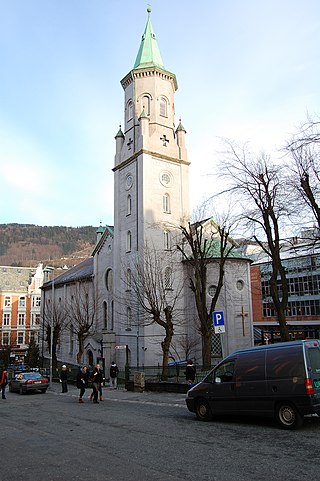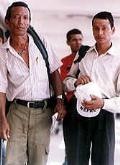
The Catholic Church in Benin is part of the worldwide Catholic Church, under the spiritual leadership of the Pope in Rome.

The Catholic Church in Norway is part of the worldwide Catholic Church. As of May 2014, there were over 151,000 registered Catholics in Norway. It is claimed there are many Catholics who are not registered with their personal identification number and who are not reported by the local church; the full number may be as high as 230,000, 70% of whom were born abroad. That constitutes about 5% of the population, making Norway the most Catholic country in Nordic Europe.

The Catholic Church in Afghanistan is part of the worldwide Catholic Church. Prior to August 2021, there were very few Catholics in this overwhelmingly Muslim country—just over 200 attend Mass in its only chapel—and freedom of religion has been difficult to obtain in recent times, especially under the new Taliban-led Afghan government.

The Catholic Church in Azerbaijan is part of the worldwide Catholic Church, under the spiritual leadership of the Pope in Rome. There are about 570 local Catholics in the country as of 2016. Azerbaijan is covered entirely by a single Apostolic Prefecture – Apostolic Prefecture of Baku – since 2011. The community is served by seven Salesian priests and two friars. In addition, there is a mission of the Missionaries of Charity.

The Catholic Church in Kuwait is part of the worldwide Catholic Church, under the spiritual leadership of the Pope in Rome.

The Catholic Church in Bhutan is part of the worldwide Catholic Church, under the spiritual leadership of the Pope in Rome. The Kingdom of Bhutan falls under the jurisdiction of the Diocese of Darjeeling (India).

The Catholic Church in Cambodia is part of the worldwide Catholic Church, under the spiritual leadership of the Pope in Rome. Throughout the Church's history in Cambodia, Catholics made up a small percentage of the country's population, and a majority of adherents have been ethnically Vietnamese; in 2005, around two-thirds of the total number of Catholics in Cambodia were Vietnamese.

The Catholic Church in Turkey is part of the worldwide Catholic Church, under the spiritual leadership of the Pope and the canonical leadership of the curia in Rome that is submitted to the Pope.

The Catholic Church in Tajikistan is part of the worldwide Catholic Church in Tajikistan, under the spiritual leadership of the Pope in Rome.

The Catholic Church in Mongolia is part of the worldwide Catholic Church, under the spiritual leadership of the Pope in Rome.

Christianity is a minority religion in Laos.

Christianity in Somalia is a minority religion within the country, which has a population over 99% Sunni Muslim, and Islam as the state religion. According to a 2020 report by the US Department of State, there are approximately 1,000 Christians in the nation.

The Catholic Church in Tonga is part of the worldwide Catholic Church under the leadership of its local bishop in communion with the Bishop of Rome. It is estimated that approximately 16% of the population of the Pacific island Kingdom are Catholic, being 15,767 in 2004.1 Bishop Soane Patita Paini Mafi succeeded as Bishop of Tonga in 2008.

The Diocese of Sapporo is a Latin Church diocese of the Catholic Church located in Sapporo, Japan.

Christianity is the religion of 3.63% of the population of Oman in 2020. Ninety Christian congregations exist in the country.

Religion in Namibia is dominated by various branches of Christianity, with more than 90 percent of Namibian citizens identifying themselves as Christian. According to the government's survey, in 2013 up to two-thirds of the country was Protestant, including as much as 44% Lutheran.

Christians in the Gambia constituted Muslim 96.4%, Christian 3.5%, other or none 0.1%.

The Catholic Church in Nauru is part of the worldwide Catholic Church, which, inspired by the life, death and teachings of Jesus Christ, and under the spiritual leadership of the Pope and Roman curia in the Vatican City is the largest Christian church in the world.

The Catholic Church in Greenland is part of the worldwide Catholic Church, under the spiritual leadership of the Pope in Rome. There are very few Catholics in this overwhelmingly Protestant territory. There are 50 registered Catholics and only approximately 4 native Greenlander Catholics out of a population of 57,000. They are part of the only Catholic parish in Greenland, in Nuuk, the island's capital. The whole island is under the jurisdiction of the Diocese of Copenhagen, Denmark.

Tokwon Abbey was a Benedictine monastery of the Congregation of Missionary Benedictines of Saint Ottilien, located near the town of Wonsan in what is now North Korea. Founded as a monastic mission in Seoul, the community transferred to Tokwon in the 1920s to take charge of the newly created Apostolic Vicariate of Wonsan. The persecution of Christians in North Korea since 1949—including the torture and murder of dozens of men and women religious—made any church activity in the abbacy impossible. However the Territorial Abbacy of Tokwon is formally still kept as one of the few remaining territorial abbeys within the Catholic Church.










